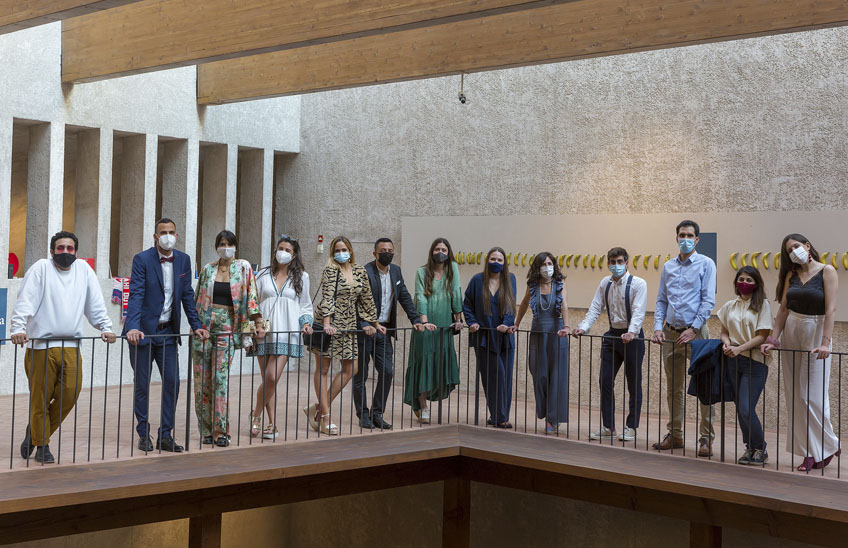The students of the 3rd promotion of the Master in Curatorial Studies of the Museum inaugurate the exhibition 'Art and Space III' at the Condestable of Pamplona.
The exhibition, which can be visited until Monday 17th, brings together four projects that reflect on the role of space and its implications in the narrative of exhibitions.

FotoMANUELCASTELLS/Inauguration of the exhibition "Art and Space III" of the students of the Master in Curatorial Studies of the Museum, at the Condestable of Pamplona.
10 | 05 | 2021
A reflection on the role of space and its implications in the narrative of exhibitions. This is the proposal put forward by the 19 students of the 3rd promotion of the Master in Curatorial Studies at the Museo Universidad de Navarra in the exhibition Art and Space III. The students, directed by professor Javier Antón, inaugurated the exhibition last Friday and it can be visited on the second floor of the courtyard of the Palacio del Condestable in Pamplona until May 17.
On the same Friday, prior to the inaugural day, which included a round table discussion, the group also celebrated their graduation in a ceremony in the Aula Magna of the Central Building of the University of Navarra. Professor Ana Marta González, godmother of the graduating class, gave the master class. Jaime García del Barrio, director of the Museum; Nieves Acedo, director of the master's program; and Leire Santos, delegate of the graduating class, also took part in the ceremony.
FOUR EXHIBITION PROJECTS
The exhibition brings together four exhibition projects, one for each working group, exploring a theme and its relation to curatorial practice. "Each student in the group investigated a case study in depth, with special emphasis on the analysis of spatial strategies as an interface between the message and the receiver," explains Professor Antón. In this sense, he stresses that "the messages of each group were intertwined with each other to enrich the way of understanding that topic in the curatorial field." Based on this work, each group designed an exhibition proposal, the result of which is presented in this exhibition under the titles Cartography, Oniric, Spectator and Temporality.
Mara Sofía López, from the team that has investigated the role of the spectator, points out a proposal centered on the Nafarroako Monumentoa (Navarre Monument). The installation brings together several elements of each case study and seeks to "invite the viewer to contribute to what he or she believes forms the Navarrese identity, to take objects away or bring others, to change their place...".
The group dedicated to investigating temporality wanted to show the concept through "putrefaction and changes in the state of the organic: on a horizontal wall, three separate groups of bananas in different states of ripeness," explains Maite Fraile. She also says that her interpretation arises from a piece by artist Claire Morgan on ephemeral art exhibited at La Casa Encendida (Madrid): "An ephemeral experience with which to reflect on the fragility, inevitability and evolution of the passage of time".
Gabriela Garcia and her colleagues worked around the concept of cartography, "a continuous procedure that emphasizes the importance of considering both the production and the consumption of the map, that is, the curatorial proposal and the audience's experience". In this line, he details that they took as a reference the exhibition The Rest, curated by the students of the 1st promotion of the master's degree and that could be visited at the museum from June to September 2020: "In that exhibition the artistic procedure of five artists was accessed through what was "discarded" in the creation process. Specifically, our proposal is a nod to the work of the artist Miren Doiz La forma dada. Creating a new cartography, we speak of exhibitions that have already been, of materials that die, of unfinished narratives and of that hidden gear behind an exhibition".
About the project in the oneiric, Jonathan Hernandez points out that "it is in the space between waking and dreaming where everything makes sense. The objects that evoke a pool where there is none are objects unusually placed in a space that cause strangeness and want to provoke bewilderment within the framework of the oneiric".
ON-SITE GRADUATION
Following all the safety measures indicated by Public Health, the students of the Master in Curatorial Studies, coming from 8 countries, were also able to graduate in a face-to-face ceremony last Friday. Professor Ana Marta Gonzalez, godmother of the graduating class, said that "knowing how to discover and convey to a public immersed in marketing, fashions and dominant cultural conventions the integrating and significant quality of art, to convey the critical and reflective look that art represents, often going beyond the pretensions of the artist, is what allows us to question the task of the curator, not as a simple cultural manager, but as part of the same artistic practice, attentive to that very personal pretension of truth characteristic of art".
For his part, Jaime García del Barrio, highlighted the work carried out by the students during the course, "intense, professional, sometimes hard, flexible, brilliant, generous and collective work, which is a great learning experience". He also reminded them of the importance of maintaining "a spirit of service and optimism" in all the projects they undertake.
Leire Santos, student delegate, valued the collective learning and thanked the teachers for having "taken them on different trips that we hope to take advantage of". She also vindicated the role of the new curators, whom she defined as "an active generation, capable of creating opportunities and prioritizing social issues over greed".